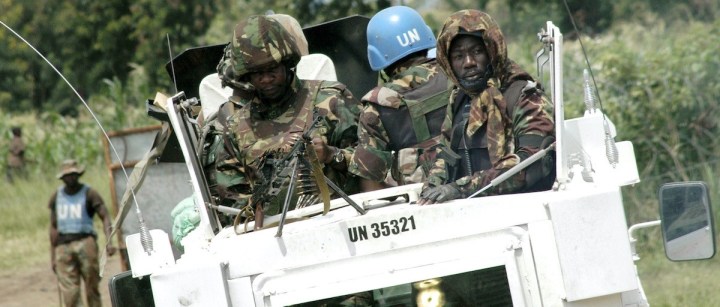ISS TODAY
SADC: Reinventing the Force Intervention Brigade in the DRC

The Southern African Development Community has finally agreed to change the rebel-fighting brigade, but the proposed new Quick Reaction Forces’ mandate is unclear.
First published by ISS Today
After seven years in the Democratic Republic of the Congo (DRC), the Force Intervention Brigade (FIB) is about to lose its all-Southern African Development Community (SADC) character. It’s also about to become quicker in protecting civilians against rebels.
The FIB was originally conceived as the more swashbuckling arm of the United Nations Organisation Stabilisation Mission in the DRC (MONUSCO), with a more robust mandate to take the fight to armed rebel groups. Composed entirely of SADC troops from South Africa, Tanzania and Malawi, it accomplished its first mission – to defeat the Rwanda-backed M23 rebels who were threatening to take control of eastern DRC – in 2013, with panache.
After that it was supposed to go after the many other rebel groups in the area. These include the Democratic Forces for the Liberation of Rwanda (FDLR) and more recently the Alliance of Democratic Forces (ADF). The ADF is now the main force terrorising civilians and is reputed to be affiliated to Islamic State.
But the FIB has not managed to neutralise these other forces. Compared with the M23, which was a conventional armed group, the ADF is mobile, operates across a wide expanse and lacks unified command and control. The FIB is not equipped to tackle these kinds of armed groups, which raises questions about its mission in the first place.
The UN has been trying to change the FIB for some time, not least because it is expensive, costing a good part of MONUSCO’s annual$1.2-billion budget. ISS senior researcher Gustavo de Carvalho says: “There has been a lot of pressure for reducing the size of FIB and MONUSCO in general. The UN’s appetite for big missions with large overheads is quite limited at this stage.
“Many feel that the future of peacekeeping will be composed of smaller missions, lower footprint, and potentially more interactive with regional and national tools. With the peacekeeping budget falling every year, the first place to look for cuts are missions that have been on the ground for long, like MONUSCO.”
Until recently, the SADC had been strongly resisting UN pressure to cut down on the FIB, include non-SADC elements and reorient its mission. This stance, however, was becoming untenable, not least because it seemed the SADC was insisting on the FIB remaining in effect a regional force under a UN mandate and budget.
Now the SADC has at last backed down. At an extraordinary summit of its security organ in Gaborone on 27 November 2020, the SADC “accepted the proposal by the United Nations to realign the current [FIB] troops’ strength to create the headroom for the Quick Reaction Forces (QRFs), and generate two QRFs from the SADC Troops Contributing Countries”.
What exactly this reconfiguration of FIB will entail, though, was not spelt out in the troika summit communiqué. SADC Secretariat officials say the two new QRFs will comprise SADC troops while the rump of the FIB will be made up of non-SADC soldiers. So it seems like something of a compromise.
The future missions of the QRFs are also not clear. The FIB has had an offensive mandate – to go after armed rebel groups, either with the DRC’s armed forces or even, it seems, without. But it stopped trying to do that some time ago. As some observers have pointed out, unlike the M23, the remaining armed groups such as FDLR and ADF are deeply embedded in local communities. This makes them hard to attack without risking collateral damage.
And, even more worrying, the ADF has pursued a cynical strategy of retaliating against civilians whenever FARDC/MONUSCO/FIB pursue it. The result has been, as the ADF intended, to discourage UN forces in particular from taking the offensive, resulting in virtual stasis. This has provoked large protests from locals demanding to know what MONUSCO and FIB are doing in the DRC, if not providing any real protection.
Will a new FIB change that, and if so, how? An SADC defence official told Daily Maverick that “FIB remains on the ground but reconfigured with the introduction of the Quick Reaction Forces Concept (with specific equipment, faster and greater mobility capabilities) to respond to the type of warfare in the theatre of operations”.
This could mean FIB and QRFs will continue with the same offensive mandate, only more agilely. Or it could mean the QRFs at least will acquire a different mandate, not to initiate military action against armed rebels like the ADF, but to respond quickly when they attack civilians.
This would align with former UN official Adam Day’s proposal that the FIB be scrapped and replaced by such rapid response units, ready to rush to the rescue of civilians under attack. Whether the QRFs could react fast enough to protect civilians or whether this is indeed their intended mission, remains unclear.
But the QRFs seem to be what UN Secretary-General António Guterres had in mind when he outlined the UN’s plan for MONUSCO’s phased withdrawal. He said MONUSCO hoped to pull back from the quieter of the six provinces where it was still present as early as 2021. This would allow MONUSCO to focus on the violent eastern provinces of North and South Kivu and Ituri, from where an exit date wasn’t yet foreseeable.
In these provinces though, “protection through projection” would be key to MONUSCO’s efforts to provide physical protection. “As troop levels are reduced progressively, the mobility and flexibility of the remaining forces will need to be enhanced to ensure effective coverage,” Guterres added. It seems this is what the reconfiguration of the FIB is aimed at. DM
Peter Fabricius, ISS Consultant


















 Become an Insider
Become an Insider
Comments - Please login in order to comment.